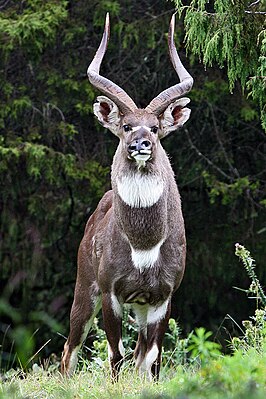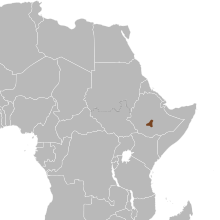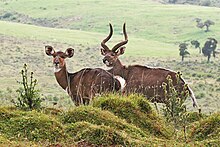Mountain nyala
| Mountain nyala | ||||||||||||
|---|---|---|---|---|---|---|---|---|---|---|---|---|

Mountain nyala ( Tragelaphus buxtoni ) |
||||||||||||
| Systematics | ||||||||||||
|
||||||||||||
| Scientific name | ||||||||||||
| Tragelaphus buxtoni | ||||||||||||
| ( Lydekker , 1910) |
The mountain nyala ( Tragelaphus buxtoni ) is an African antelope . The name suggests that it was previously thought to be a close relative of the nyala ; today it is considered more likely that it is a sister species of the greater kudu . The Mountain Nyala is supported by the IUCN as vulnerable ( endangered classified). The mountain nyala was only discovered in 1908 and is considered to be the last large artifacts of the African fauna to be discovered. The mountain nyala is still a little researched species.
Appearance
In their general proportions and size, the hornless females resemble Central European hinds. They have a gray-brown fur with a lighter underside. Compared to the great kudu, the scattered points and stripes are only weakly pronounced and hardly visible. They reach a body length of 190 to 200 cm and a weight of 150 to 200 kg. The horn-bearing adult bucks can be almost twice as heavy as the cows with a weight of 180 to 300 kg and with a body length of 240 to 260 cm almost reach the dimensions of the great kudu. The fur is sepia brown and longer in the males than in the females, especially in the area of the shoulders and neck and it forms a crest on the back. There are clear white markings on the neck and others on the face, ears and front legs. The fur becomes darker with age and can become very shaggy during the cold season. The horns vary in thickness, length and number of helical turns and can be up to four feet long, measured along the curve.
distribution
The distribution area covers only 150 km² in the highlands of Ethiopia , mainly in the Bale and Arussi mountains . Here he lives in mountain forests at altitudes between 2500 and 3500 meters. It is an antelope with an unusually small habitat. In addition to the mountain nyala, only the Abbott duiker is limited in its distribution to mountain forests.
Reproduction
The female of the mountain nyala gives birth to a young after a gestation period of 7.5 to 8 months. This can stand and run after just a few hours.
Duration
It was not until 1908 that this species was discovered for western science by Richard Lydekker . Since then, the already small stocks have continued to decline due to illegal trophy hunting . From 8,000 animals around 1960, the population has now fallen to below 3,000. The IUCN classifies the mountain nyala as threatened.
literature
- CA Spinage: The Natural History of Antelopes . Croom Helm, London 1986, ISBN 0-7099-4441-1
- J. Kingdon: The Kingdon Field Guide to African Mammals . Academic Press 1997, ISBN 0-7136-6513-0
Web links
- Tragelaphus buxtoni in the endangered Red List species the IUCN 2006. Posted by: Antelope Specialist Group, 1996. Retrieved on 9 May, 2006.

